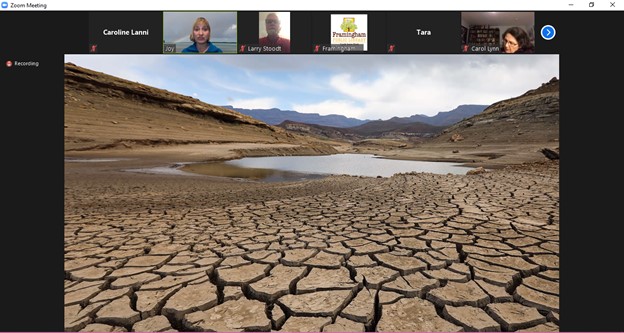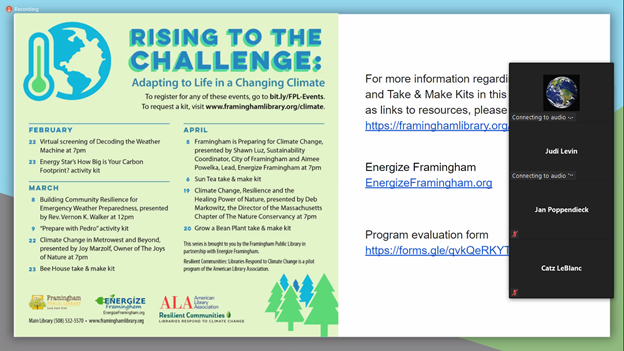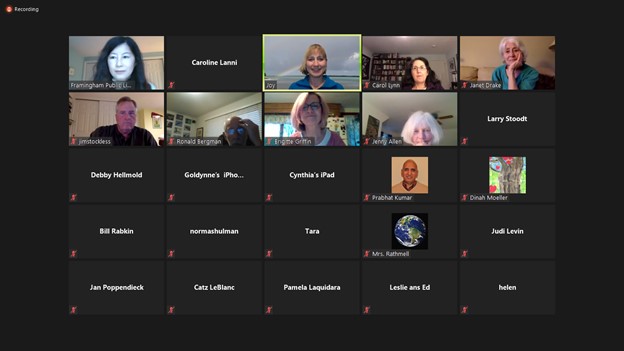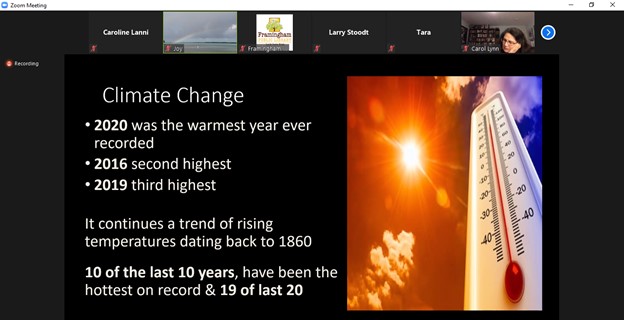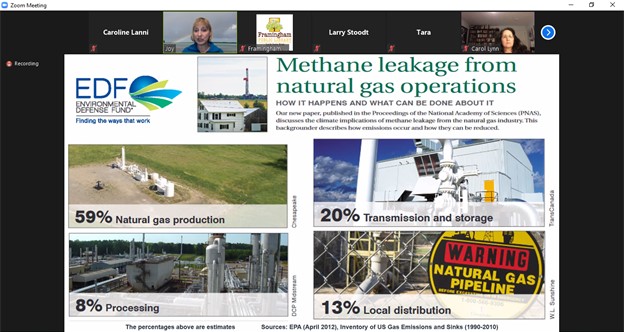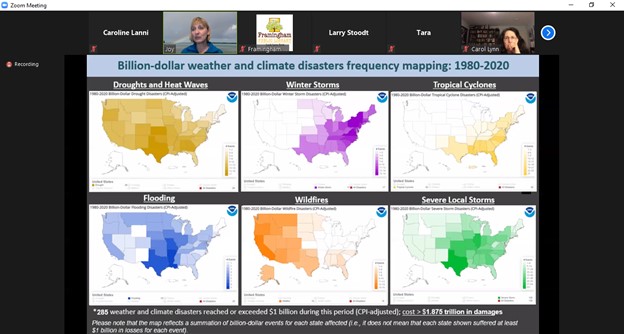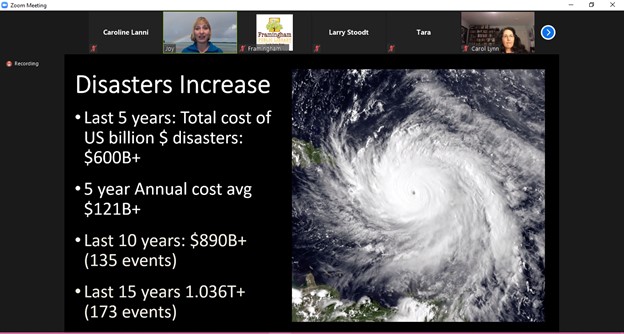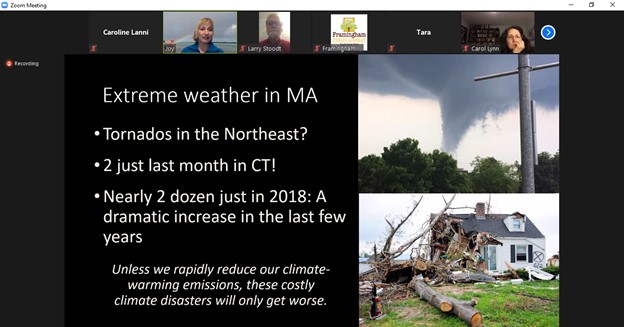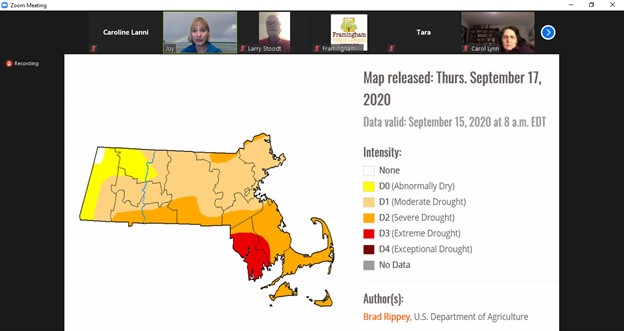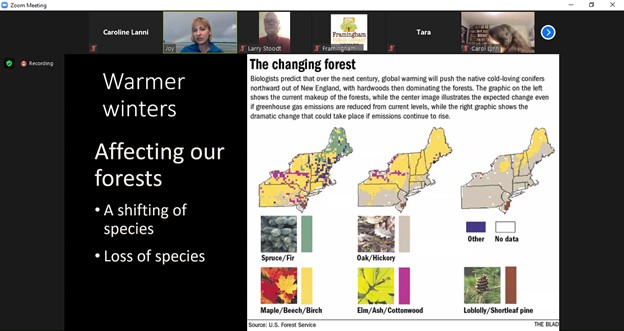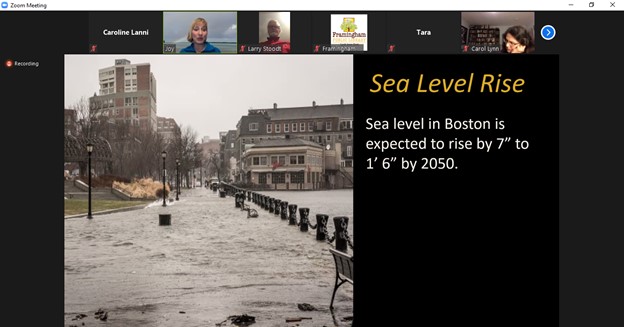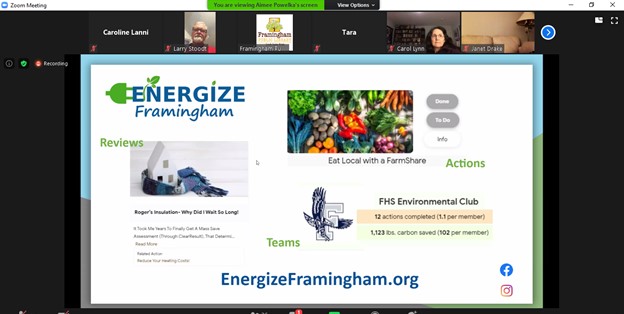By Caroline Lanni
***

FRAMINGHAM – Climate Change in MetroWest was the focus of a Zoom session on march 22 hosted by Framingham Public Library in conjunction with Energize Framingham.
Joy Marzolf, founder of The Joys of Nature, which is a virtual educational children’s program, has the features speaker.
Marzolf started her own virtual small business when COVID-19 made her previous place of employment move to virtual and jobs like hers were eliminated. For more than 13 years, she worked at Mass Auto Bonds for over 13 years, until she launched her own business The Joys of Nature last summer.
A Framingham resident since 2006, she became a member of Energize Framingham, a volunteer organization to promote actions aimed at improving environmental sustainability in Framingham, in the Fall.
Marzolf said that she is starting to partner with libraries to hold these virtual events to discuss climate change more.
“Using our resources wisely is a smart thing to do, due to COVID-19,” said Marzolf.
The Joys of Nature holds virtual educational programs. Marzolf has been educating about climate change for years.
Aimee Powelka, community lead of [Sustainable] Energize Framingham said, “Energize Framingham is a community-building tool to help everyone from renters to retirees feel empowered to take action to address climate change. The website collects recommendations
from neighbors, provides information and steps to take on sustainability actions, and allows people to form teams for collaboration or competition. We then are able to show our collective climate impact – how many households engaged, actions taken, and pounds of CO2 [Carbon Dioxide] reduced.”
[broadstreet zone=”53130″]
Marzolf focused on talking about climate change and how people in and around the City of Framingham are making “strides,” but there is still more to do.
“We hope that these programs and events help Framingham residents, young and old, to understand, prepare for, mitigate, and adapt to climate change. An educator and a naturalist, Joy Marzolf delivers an informative and engaging presentation about the environmental changes we have seen in the MetroWest area and beyond due to climate change and the steps we can take to make a difference,” said Framingham Public Library staffer Helen Liu.
“The key to Climate Change is that it is all around us and it is already happening,” said Marzolf.
People need to understand how climate change is affecting them now and in the future, she said.
Marzolf said to the audience that, the year of 2020 was the warmest year and, “10 of the last 10 years, have been the hottest on record.”
We should consider how that is affecting us and how it will affect our future, she said.
There are four climate sciences, heat-trapping blankets, regular vs rampant carbon dioxide [CO2,] oceans equaling the climate of the heart, and osteoporosis, according to Marzolf’s presentation.
“Some greenhouse gases already occur naturally in nature, – but others will increase or result in human activity, so naturally occurring greenhouse gases include – water vapor, carbon dioxide, even naturally occurring methane, nitrous oxide, and ozone,” said Marzolf.
Some activities can add to this level of naturally occurring gases, due to human impact on things, “such as nitrous oxide is added during agriculture activities, combustion of solid waste and fossil fuels, methane, and HFC’s [Hydrofluorocarbon,] being omitted from
industrial processes that are not naturally occurring, she explained.
[broadstreet zone=”58610″]
“There are chemicals that are naturally being put out there from human activities – and some that are just made from human activities,” said Marzolf.
She brought up how humans are affecting the climate with the choices they make every day. Those choices consist of fueling sources for power such as transportation, and industry. That land of development releases greenhouse gases, and the more those gases increase the hotter days we will have – the increased extreme precipitation, and greater amounts of sea level will rise., she added.
Marzolf said something people might not be aware of is that methane can be leaking from natural gas operations.
She showed in her presentation that the places that release this methane consist of, 59% of natural gas productions, 20% transmission and storage, 8% processing, and 13% local distributions, according to the EDF [Environmental Defense Fund.]
“There are some efforts to try to capture this – efforts to capture it [methane] but they are not all being taken,” Marzolf said.
These issues are happening all around the world, and “you first need to find them in order to be able to fix them,” Marzolf added.
“A lot of companies are starting to use space age technology – literally satellites, to find where the biggest methane leaks are in order to try and stop them,” she said.
Marzolf showed the audience a chart about 2020’s billion-dollar disaster event count based on the Weather and Climate Disasters Information.
“So, it [according to the chart] has the most billion-dollar events of any year so far,” said Marzolf.
[broadstreet zone=”59947″]
Marzolf also showed the frequency map which was across the nation where places are having specific issues regarding droughts and heat waves, winter storms [Massachusetts,] tropical cycles, flooding, wildfires, and severe local storms.
Disaster storm history was discussed at this event and Marzolf said that in the last five years the total cost of U.S. billion dollars due to disasters resulted in more than $600 billion, provided this information from [National Oceanic and Atmospheric Administration] NOAA.
“It is a big deal that we are seeing this impact and if you’re familiar with insurance companies they’re doing the data analysis right now – it’s costing them, which means it’s also costing us,” Marzolf said. “Insurance rates are going up for homeowner’s insurance or other kinds of insurance because of disasters found throughout the country.
Severe weather is “on the rise,” she said.
There has been extreme weather in Massachusetts such as tornadoes occurring recently, she added.
Marzolf said that, “Nearly two dozen just in 2018 [tornadoes] – a dramatic increase in the last few years. “Unless we rapidly reduce our climate warming emissions, these costly climate disasters will only get worse.”
These tornados came to be in Massachusetts when tropical air masses work up from the south coming from warm fronts, said Marzolf.
Other changes that were noticed by Marzolf were more extreme weathers, warmer winters, and a wetter spring.
“Remember one storm is weather – multiple storms over time is climate change,” she said.
[broadstreet zone=”59948″]
We are seeing nor’easters occur more and becoming more intense, said Marzolf.
More flooding is occurring and Marzolf said, “that is something we are seeing, and we are going to have to resolve here in our City,” since the snow melts more quickly.
“Many factors to this change including climate change, overuse of water resources, and overgrazing of livestock have all exacerbated the problem,” Marzolf said.
For Massachusetts Marzolf said that in September in 2020 there were droughts and there are areas that are abnormally dry in March 2021 now from NOAA.
According to WBZ, Boston recorded history of the driest first half of March coming in at number four was 2021 with 0.18% from this year.
“Estimated over time Boston may experience 33 days per year that exceed 100 degrees by 2100,” she said.
Marzolf said with greater risks in heat waves and hot nights there would be more hospitalizations.
These increases in temperatures and drought have affected wildlife, she said.
Marzolf showed as an example that vernal pools are drying up too fast and egg masses and tadpoles will not survive.
“They are adapted to areas that will dry up, but not that quickly,” she added.
According to Marzolf she said, “In the past few decades severe and prolonged episodes of drought are becoming commonplace throughout North America – we are seeing impacts on tadpoles and frogs that provide food for many other species.”
Many other species will be affected by the droughts, like copperheads that depend on frogs and toads that require water to multiply and that would change their numbers in the future.
[broadstreet zone=”59983″]
Marzolf moved to discuss warmer winters and how, “There hasn’t really been the same regular snow for skiing and snowshoeing in the last say 15 years that there used to be.”
Warmer winters are affecting our trees, said Marzolf and how it is going to impact us over time.
“Climate change is causing slower growth and may cause the absolute loss of this species of tree here in Massachusetts, most temperate species including sugar maples have a chilling requirement they’ve got to go through a cold period in order to actually get that sap flowing,” and a number of cold days as well, so cold winter days are required sometimes, said Marzolf.
Warmer winters also affect our forests with a shifting of species and loss of some species like birds.
Marzolf said that climate change is also affecting poison ivy and is being found on more plants and is becoming a stronger chemical from the plants.
According to studies, said Marzolf, that the uritial is stronger if the carbon dioxide [CO2] is increasing as well.
“Poison ivy loves carbon dioxide,” she added.
Warmer winters are also impacting other species, like snakes, they are emerging too quickly from hibernation thinking it is Springtime when it is still winter and temperatures changing drastically dangering them, said Marzolf.
Species such as caterpillars, spruce trees, and an increase in pine beetles are being affected due to warmer winters all around the world due to the changing seasons, she added.
Inland flooding is occurring as well and how if it were snow it would take much longer to melt not causing flooding in the areas and would be more spread out, she added.
[broadstreet zone=”59982″]
The storms and rising waters affect the local red-winged blackbirds since their nests are built close to the surface, and “their babies are also at risk from the heat of the storms and the rise of water,” due to the chance of them drowning, she said.
Warmer weather is bringing new species to the north, said Marzolf like the red belly woodpecker only common to Massachusetts for the last two decades.
“Everybody [other birds] is moving North,” said Marzolf.
Later and wetter springs are affecting other wildlife due to shifting temperature patterns, she said.
“So, shifting temperature patterns are actually changing when certain insects emerge – dragonflies in 2018 the spring warming was so late dragonflies were over five weeks late causing mosquitoes to be out without predators for a longer period of time,” said Marzolf.
Tree swallows are long distance migrants that breed in New England and their numbers have declined faster than other resident birds – “these migratory species cannot adjust their migration schedules enough to coincide with the shifting peak abundance of their faraway
food sources, they are going to leave when they leave, so it may lead to food availability for not only the adults, but also the juveniles,” said Marzolf.
“Trees and flowers are shifting when they’re emerging, trees and shrubs actually respond to air temperatures, not soil temperatures,” she said, adding this will affect flowering and leaf emergence and that it can also affect fruiting times.
“If you have allergies you may have noticed the growing season in Massachusetts is approximately 10 days longer than it was before 1960 – especially ragweed pollen season increasing,” said Marzolf.

Forests are “definitely” being altered, said Marzolf. The differences are with tree shrubs and flowers.
An example Marzolf showed in the presentation was, the flower forsythia being an early flowering shrub due to it responding to air temperatures.
“This will also affect food sources for wildlife like insects, so if the insects are not out when the flowers are flowering that can make a big difference for pollination,” said Marzolf.
Black-eyed Susan flowers are increasingly late in the past 10 years since these emerging plants respond to ground temperatures.
So, if animals are coming back early and the plants are later then their food source is not available to them, yet which will cause problems, said Marzolf.
People might be noticing more fungus in their gardens – on their tomatoes, even more fungal diseases in more animals like snakes, and seeing a trend overtime.
Sea level rise is another thing affecting us, said Marzolf.
“Warming water causes land and sea ice to melt and sea water to expand so warming water alone will cause expansion and sea level rise so overall we’re seeing a lot of melt water going in from examples like these glaciers,” according to Marzolf when she visited Alaska.
Marzolf was in Alaska in 2009 and reported that the temperature was 75 degrees in August that year on land showcasing that temperature is increasing and snowpack’s going down. She said that this is affecting Boston due to the resulting flooding and, “sea level in Boston is expected to rise by seven inches to one foot and six inches by 2050.”
[broadstreet zone=”59945″]
“Since 1922 the sea levels in Boston Harbor have risen by 10.4 inches,” and how that will affect communities during storms, she added.
In Framingham we would be affected by other effects the ocean will bring.
“Not only is fresh water coming in and leading sea level rise but if warmer water starts to stop moving off our coast that’s one thing that actually keeps us warmer in the winter than places like North Dakota – but warming ocean circulation keeps those somewhat warming waters off our coast, it’s definitely warmer than it could otherwise be so the circulatory system of the ocean is affected by extra fresh water coming in and changes in the water coming in from glaciers, so definitely coastal flooding is predicted to increase,” said Marzolf.
That flooding will increase habitat loss, she added.
When baby turtles come out and the sex of the turtle is determined by the temperature of the egg – the warmer the temperature the more females, and the nests are also affected by sea level rise.
In the future, they are seeing more habitat loss, more species moving, and more species lost.
“The black-sapped chickadee is at risk of leaving the State and moving North,” which would be sad to lose our State bird, Marzolf added.
Marzolf talked about osteoporosis of the sea and how, “carbon dioxide [CO2] from fossil fuels is causing osteoporosis of the sea,” which damages the shells of many creatures that protect them and disrupts the marine ecosystems.
Osteoporosis affects coral reefs and other things in the ocean, such as coral bleaching, she said.
Marzolf added that local marine life is being affected by the ocean acidification and calcium bases shells.
This would impact popular New England dishes like clam chowder.
How clams require the calcium to be brought out of the ocean – for ocean acidification clams will have a harder time building their
shells, which also applies to oysters, she said.
Clams and oysters also are “a big part of the food chain that filter feeders and also provide a lot of food for wildlife as well,” she added.
Marzolf said that there is a decline in sea stars due to diseases of wasting that affect them and affects the food chain.

She said, people can do things to help such as, electric cars, or more fuel-efficient hybrids, drive less and bike more, solar panels on your houses, energy efficient heat systems, natural solar heating, LED lights, saving water and put an energy efficient and water efficient in, install rain barrels, using natural products, eating local, and composting to reduce waste.
“Being greener saves us money too,” said Marzolf.
Individuals can act, by reducing your plastics made from fossil fuels, and bring reusable cloth bags for fruits and veggies to the store.
Aimee Powelka said, “People in Framingham are noticing the impacts of climate change – earlier spring, drier summers, more flooding. In her talk for the FPL’s Climate Resiliency series, Joy Marzolf pointed out additional local changes, from new birds to increased toxicity of poison ivy
due to climate change. She related national and international climate events in the news back to our local environment, such as the smoke from the Pacific Northwest fires last summer drifting here.
“Joy concluded with actions that we all can take to help adapt to climate change and ways to reduce our own carbon emissions.
Gardeners can help local pollinators with native plants, households can subscribe to a curbside compost service, homeowners and landlords can make their buildings more efficient, and renters can drive a hybrid or electric car and get LED light bulbs from Mass Save,” she added.
When purchasing appliances read the energy efficiency rating.
“Eliminate use of chemicals that kill our beneficial insects,” she said.
The City of Framingham is now working with a non-profit Call All in Energy at 978-237-4530 from Monday- Friday 9 a.m. to 5 p.m. or visit FraminghamSaves.org.
“This is a special opportunity for Framingham I would say having a customer advocate by your side,” said Powelka.
***
Caroline Lanni is a 2021 spring SOURCE intern. She is a senior at Framingham State University. Screenshots by Lanni.

***

